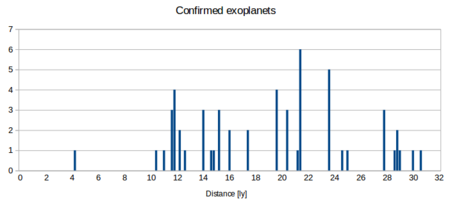List of nearest exoplanets
Several confirmed exoplanets are hypothesized to be potentially habitable, with Proxima Centauri b and GJ 1002 b (15.8 ly) considered among the most likely candidates.
[7] The International Astronomical Union has assigned proper names to some known extrasolar bodies, including nearby exoplanets, through the NameExoWorlds project.
[11] Unlike for bodies within the Solar System, there is no clearly established method for officially recognizing an exoplanet.
Some studies have calculated this to be somewhere around 13 times the mass of Jupiter, and therefore objects more massive than this are usually classified as brown dwarfs.
[119] Excluded from the current list are known examples of potential free-floating sub-brown dwarfs, or "rogue planets", which are bodies that are too small to undergo fusion yet they do not revolve around a star.

